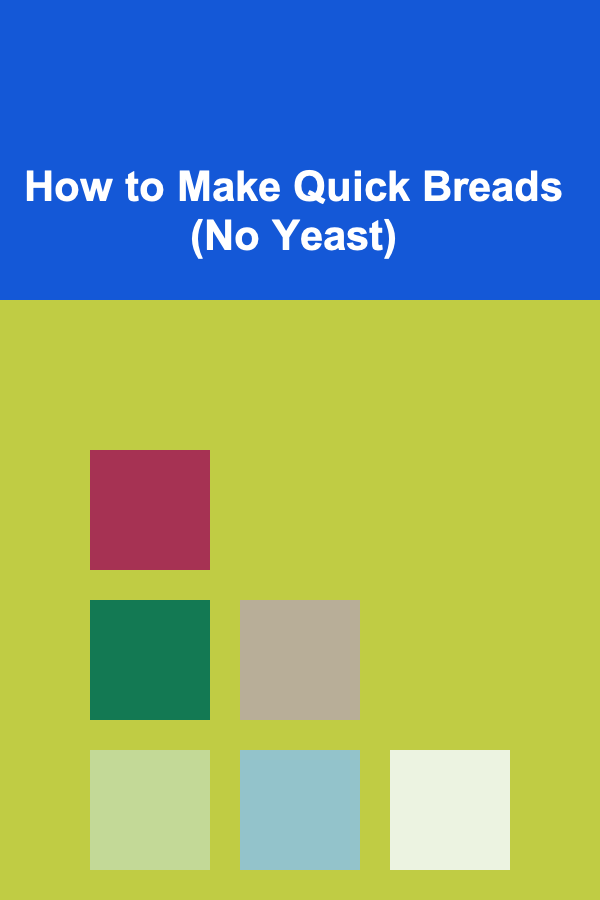
How to Make Quick Breads (No Yeast)
ebook include PDF & Audio bundle (Micro Guide)
$12.99$6.99
Limited Time Offer! Order within the next:

Quick breads are a class of baked goods that are easy to prepare and don't require the time-consuming process of yeast fermentation. These types of bread are leavened with baking powder, baking soda, or other chemical leavening agents rather than yeast, making them ideal for those who want to enjoy homemade bread without waiting hours for the dough to rise. Quick breads are diverse, ranging from sweet muffins to savory cornbread, and can be flavored with various ingredients to suit your preferences.
In this article, we will explore the basics of making quick breads, the different types of quick bread, the ingredients involved, the methods, and some tips for making the perfect loaf or muffin. Whether you're a beginner in the kitchen or an experienced baker, this guide will help you master the art of quick bread making.
Understanding Quick Breads
Quick breads are named as such because they do not require yeast, and instead use leavening agents like baking powder or baking soda. The leavening agents cause the bread to rise quickly without the need for fermentation. Yeast, which requires time to grow and rise, is typically used in traditional bread-making. In contrast, quick breads can be made in a matter of minutes and baked within an hour, making them perfect for busy cooks or when you want to avoid the waiting game.
Unlike yeast breads, which are kneaded and require proofing before baking, quick bread dough is mixed together, placed in a baking pan, and immediately baked. This makes quick breads a great option for those who want to enjoy fresh bread without spending a lot of time in the kitchen.
Types of Quick Breads
Quick breads come in many different forms, each with its unique ingredients and flavor profile. Below are some common types of quick bread:
- Banana Bread: A moist, sweet bread made with mashed bananas and flavored with vanilla, cinnamon, and sometimes nuts. This bread is one of the most popular forms of quick bread and is a great way to use overripe bananas.
- Muffins: These small, individual loaves can be sweet or savory. Sweet muffins may include ingredients like blueberries, chocolate chips, or nuts, while savory varieties could have cheese, bacon, or herbs. Muffins are a great breakfast option or snack.
- Zucchini Bread: A moist, flavorful bread made with grated zucchini. It is typically flavored with cinnamon and nutmeg, and often includes walnuts or raisins for added texture.
- Cornbread: A Southern classic, cornbread is a savory quick bread made with cornmeal. It is often served as a side dish with soups, stews, or chili.
- Scones: Though similar to muffins, scones are typically richer and denser, made with cream or butter and sometimes sweetened with sugar. They are often enjoyed with tea or jam.
- Biscuits: Biscuits are a type of quick bread that is flaky and tender, often served with gravy or used for breakfast sandwiches. They are usually made with butter or shortening and baking powder.
- Irish Soda Bread: This dense, hearty bread is traditionally made with baking soda, buttermilk, flour, and salt. It is often served alongside stews and soups.
Key Ingredients for Quick Breads
The beauty of quick breads lies in their simplicity. You can create delicious, flavorful bread with just a few basic ingredients. Let's take a closer look at the essential ingredients that go into most quick breads:
1. Flour
Flour is the backbone of any bread recipe. For quick breads, all-purpose flour is commonly used because it provides a balanced texture. However, other types of flour, such as whole wheat flour or cake flour, can also be used to achieve different results. Whole wheat flour adds a nutty flavor and denser texture, while cake flour produces a lighter, more delicate crumb.
2. Leavening Agents
Leavening agents are crucial to the success of quick bread. Instead of relying on yeast, quick breads use baking soda or baking powder.
- Baking Soda: This leavening agent is used when the recipe contains acidic ingredients like buttermilk, yogurt, or vinegar. Baking soda reacts with the acid to create carbon dioxide, which causes the dough or batter to rise.
- Baking Powder: Baking powder contains both an acid and a base, so it can leaven a batter or dough without the need for an acidic ingredient. It is commonly used in recipes where no acidic ingredients are involved, such as in plain cornbread or muffins.
3. Liquids
Liquids are necessary to hydrate the dry ingredients and form the batter. Common liquid ingredients for quick bread include milk, buttermilk, yogurt, eggs, and fruit juices. The type of liquid you choose can affect the texture and flavor of the bread.
- Buttermilk is often used in savory quick breads and imparts a tangy flavor while reacting with baking soda for a light texture.
- Milk is a neutral liquid and provides a smooth texture to the batter.
- Fruit Juices or purees (such as mashed bananas or applesauce) can be used to add flavor and moisture to sweet quick breads.
4. Fats
Fats contribute to the texture and moisture of the bread. Common fats used in quick bread recipes include butter, vegetable oil, and shortening. Each fat brings a different quality to the bread:
- Butter adds richness and flavor, giving the bread a tender crumb and a slightly crisp crust.
- Vegetable Oil creates a moist, soft texture and is often used in recipes like banana bread or zucchini bread.
- Shortening can create a very tender crumb and a slightly lighter texture.
5. Sweeteners
While many quick breads are savory, sweet varieties often require a sweetener. The most common sweeteners for quick breads are granulated sugar, brown sugar, honey, or maple syrup. Sweeteners not only add sweetness but also contribute to the texture and color of the bread.
- Granulated Sugar: The most common sweetener used in quick breads, granulated sugar dissolves easily and contributes to the rise of the bread.
- Brown Sugar: Brown sugar, with its molasses content, adds a deeper flavor and moisture to sweet breads.
- Honey or Maple Syrup: These liquid sweeteners add a unique flavor and moisture to the bread, making them ideal for more fragrant or spiced varieties.
6. Eggs
Eggs serve several purposes in quick bread recipes. They help bind the ingredients together, provide moisture, and contribute to the leavening process. Eggs can also add richness and a slight golden color to the crust.
7. Flavorings and Add-ins
Flavorings and add-ins are where you can get creative with your quick bread. Common additions include:
- Spices: Cinnamon, nutmeg, cloves, and ginger are frequently used in sweet quick breads, while herbs like rosemary, thyme, and sage are used in savory breads.
- Nuts and Seeds: Walnuts, pecans, almonds, sunflower seeds, or pumpkin seeds can add crunch and flavor to quick bread.
- Fruits: Bananas, berries, raisins, and dried fruits like cranberries or apricots can bring sweetness, moisture, and flavor complexity.
- Chocolates and Other Mix-ins: Chocolate chips, cocoa powder, or chunks of fruit or candy bars can make quick breads decadent and irresistible.
Basic Method for Making Quick Breads
The process for making quick bread is relatively simple and involves just a few basic steps. Here's a general method you can follow for most quick breads:
1. Preheat the Oven
Always preheat your oven before you start mixing your ingredients. This ensures that the bread will bake evenly. The typical temperature for quick breads is around 350°F (175°C), but this may vary depending on the recipe.
2. Prepare Your Baking Pan
Grease your baking pan with butter or cooking spray to prevent the bread from sticking. If the recipe calls for it, you may also line the pan with parchment paper.
3. Mix the Dry Ingredients
In a large bowl, whisk together the dry ingredients---usually flour, leavening agents (baking powder or baking soda), and spices. If you're using any dry add-ins like nuts or chocolate chips, you can also fold these into the dry ingredients at this stage to prevent them from sinking to the bottom.
4. Mix the Wet Ingredients
In a separate bowl, whisk together the wet ingredients---such as eggs, milk, oil, and any flavorings (like vanilla or fruit purees). Make sure to mix them well to ensure they're fully incorporated.
5. Combine Wet and Dry Ingredients
Make a well in the center of the dry ingredients and pour the wet ingredients into it. Use a spatula or spoon to gently mix the ingredients together. Be careful not to over-mix, as this can lead to a dense bread. Stir until just combined, leaving a few lumps in the batter.
6. Bake
Transfer the batter to the prepared baking pan and smooth the top with a spatula. Place the pan in the preheated oven and bake for the time specified in your recipe, typically 40--60 minutes. You can check if the bread is done by inserting a toothpick into the center. If it comes out clean, the bread is ready.
7. Cool
Let the bread cool in the pan for 10-15 minutes before transferring it to a wire rack to cool completely. This helps to prevent the bread from becoming soggy.
Tips for Perfect Quick Breads
- Don't Overmix: Overmixing quick bread batter can lead to tough, dense bread. Stir the batter just until the ingredients are combined.
- Use Room Temperature Ingredients: Ingredients like eggs, milk, and butter should be at room temperature for the best results. Cold ingredients can cause the batter to seize up and affect the texture.
- Test for Doneness: Quick breads are done when a toothpick inserted into the center comes out clean. If the bread is still wet, bake it for a few more minutes.
- Don't Open the Oven Too Early: Opening the oven door before the bread has set can cause it to collapse. Wait until the bread is near the end of the recommended baking time before checking it.
Conclusion
Quick breads are a fantastic way to enjoy homemade bread without the need for yeast or long preparation times. Whether you're craving a sweet loaf of banana bread or a savory batch of cornbread, the possibilities are endless. With a few basic ingredients and simple methods, anyone can create delicious, fresh bread in no time.
By understanding the ingredients and techniques that go into quick bread making, you can experiment with different flavors and textures, creating breads that suit your taste and style. So, roll up your sleeves, preheat your oven, and start baking your own quick bread creations today!

Building Confidence for Interviews: Techniques that Work
Read More
How to Build a Checklist for Creating Event Signage and Branding
Read More
How to Create a Budget-Friendly Home Office Setup
Read More
How to Create a Shared Hobby Corner
Read More
How to Refinance Loans for Better Financial Health
Read More
**10 Tips for Organizing Your Snowboard Instructor Gear**
Read MoreOther Products

Building Confidence for Interviews: Techniques that Work
Read More
How to Build a Checklist for Creating Event Signage and Branding
Read More
How to Create a Budget-Friendly Home Office Setup
Read More
How to Create a Shared Hobby Corner
Read More
How to Refinance Loans for Better Financial Health
Read More